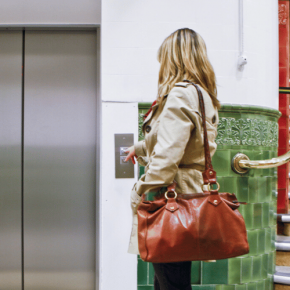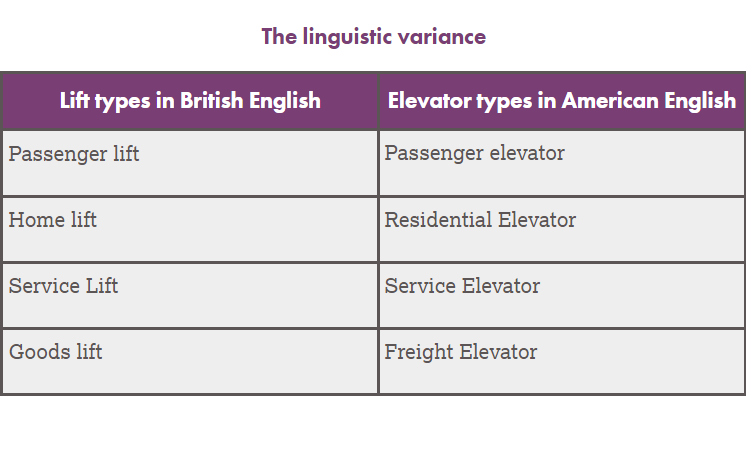
Stannah: Lift or elevator? The history and origin
The Cambridge English Dictionary definition of a lift (noun) is a device like a box that moves up and down, carrying people or goods from one floor of a building to another. But Americans and Canadians use the term ‘elevator’. Why is this? And what’s the lift’s history? Stannah explore…
Perhaps the reason for the ‘elevator vs lift’ linguistic mystery can be traced back to the nationality of its inventor or the evolution of language in different nations.
Who invented the first lift or elevator?
The first primitive lift was constructed by the Ancient Greek mathematician Archimedes in the 3rd century BC. The simple lifting platforms were used in the tunnels and animal pens beneath the Colosseum for gladiator battles.
Other early examples
One of the first one-person passenger lifts was built in 1743 for King Louis XV in Versailles and was described as a ‘flying chair’ – a counterweight lift – that allowed the King to access the apartment of his mistress.
Louis XV and his guests could also dine without being watched by servants at the Chateau de Choisy thanks to a ‘flying table’. The dinner table was loaded with food by servants in the basement, then hoisted into the dining hall through a sliding hatch, with bells to signal that the table was on its way.
In 1793, Ivan Kulibin constructed and installed the first lift driven by a screw-drive mechanism in Winter Palace, Saint Petersburg. The lift design was the precursor to the modern passenger lift and marked a significant historical step.
19th Century hydraulic lifts
The industrial revolution furthered the development of the lift. Steam-powered lifts made it possible to transport goods in bulk in mines and factories. The first hydraulic lifts, known as ‘ascending rooms’, were constructed in 1823 in Britain by Burton and Hormer, two London architects and designed as a tourist attraction for paying customers, allowing them a panoramic view of London. However, the ropes were considered unsafe for passenger travel.
The first ‘safety elevator’
In 1852 Elisha Graves Otis, an American inventor, demonstrated his new free-fall prevention mechanism at the 1853 World’s Fair in New York, ensuring the cab wouldn’t fall if the cable snapped. He raised a platform above a crowd, then cut the cable with an axe, revolutionising the vertical transport industry. Groups of people could now move vertically with improved safety.
On 23 March 1857, at the Haughwout Department Store in New York City, United States, Otis installed the world’s earliest ‘passenger elevator’ powered by a steam engine. It could travel five floors in less than a minute and was immediately pronounced a success.
The first ‘electric lift’
In 1880 Werner von Siemens, a German electrical engineer built the first electric passenger lift. Still, other innovations were at the forefront of his mind, and although he didn’t continue developing the lift itself, his ideas influenced lift design in the years since.
The Stannah family business
Around the same time, Joseph Stannah was running the company in London in 1867. Initially a manufacturer of cranes and hoists for transporting ships’ cargo, the company began to make hand-powered passenger lifts at the turn of the 20th century. Earliest records show hydraulic passenger lifts advertisements in building dating from 1877.
Today, Stannah supplies and installs a complete range of safe and reliable lifting solutions, including passenger lifts, platform lifts, goods and service lifts, escalators, moving walkways, home lifts and stairlifts.
Whatever you call them, the company can help you select the right lift solution for your project.
The evolution of language
According to the playwright George Bernard Shaw, ‘England and America are two countries separated by the same language’. Both countries have their unique linguistic history.
If we travel back to the 1200s, we find the word lift. The British adopted word is derived from the Old Norse word ‘lypta’, which means ‘to raise’. By the 1930s, ‘lift’ had become Britain’s widely accepted term for a vertical transportation device.
The term ‘elevator’ the Americans adopted came from the Latin word ‘elevare’, meaning to ‘raise up’ and was used since the early 1800s. We also know that the word elevator was used to differentiate passenger lifts from goods lifts, which the Americans called ‘hoists’.
What’s the difference between an elevator and a lift?
Elevators impact the design and architecture of a building; they move vertically and take you up and down a building – a vertical compartment that transports you to one or multiple floors.
Lifts and elevator are synonyms. The only difference is that elevator is an American term, and lift is a British term for the same type of machinery. Both are used interchangeably and refer to the device that carries people and goods to different building levels.
This innovation has transformed our cityscapes and buildings; it transports people that may not be otherwise able to travel, gives convenience and has been instrumental in developing multi-storey buildings.
So the next time you’re in London or New York, don’t get hung up about the difference between the word ‘lift’ or ‘elevator’. Just appreciate the linguistic diversity between the two countries and enjoy not having to take the stairs!
Visit Supplier's page
Latest news

26th July 2024
Enfield Speciality Doors completes world-class project for Atlas Copco HQ
A rundown office and warehouse building completely transformed into a modern headquarters for Atlas Copco has been fitted with more than 120 internal fire doors from Enfield Speciality Doors.
Posted in Access Control & Door Entry Systems, Articles, Building Industry News, Building Products & Structures, Building Systems, Case Studies, Doors, Interior Design & Construction, Interiors, Posts, Restoration & Refurbishment, Retrofit & Renovation, Security and Fire Protection, Sustainability & Energy Efficiency, Timber Buildings and Timber Products, Wooden products
26th July 2024
Abloy UK launches new white paper
Abloy UK, a leading provider of security and access control solutions, has launched a new white paper.
Posted in Access Control & Door Entry Systems, Architectural Ironmongery, Articles, Building Industry News, Building Products & Structures, Building Services, Doors, Facility Management & Building Services, Health & Safety, Information Technology, Innovations & New Products, Publications, Research & Materials Testing, Security and Fire Protection
26th July 2024
MCRMA Member Profile: David Roy, Director of Roofconsult
David Roy of MCRMA member company Roofconsult has more than 50 years’ experience to draw upon working in the building envelope sector and a unique perspective on how it has changed in that time.
Posted in Articles, BIM, Infrastructure & CAD Software, Building Associations & Institutes, Building Industry News, Building Products & Structures, Building Services, Building Systems, Cladding, Information Technology, Restoration & Refurbishment, Retrofit & Renovation, Roofs, Walls
26th July 2024
Strand: Enhancing Door Functionality and Safety
Craig Fox, Sales Director for Strand Hardware, outlines how door industry professionals might apply door limiting stays…
Posted in Architectural Ironmongery, Articles, Building Industry News, Building Products & Structures, Building Services, Doors, Facility Management & Building Services, Health & Safety, Restoration & Refurbishment, Retrofit & Renovation
 Sign up:
Sign up: /stannah_old_photo%20(300%20%C3%97%20300px)%20(600%20%C3%97%20398px).png?width=300&height=199&name=stannah_old_photo%20(300%20%C3%97%20300px)%20(600%20%C3%97%20398px).png)
